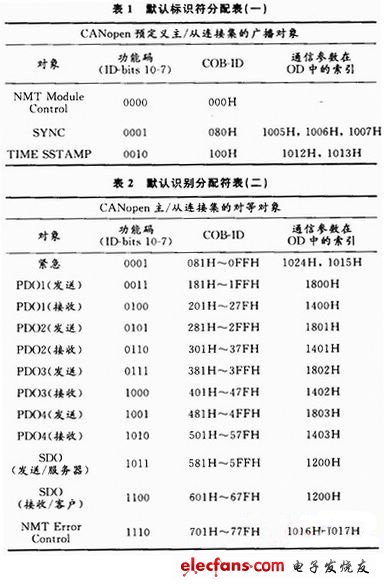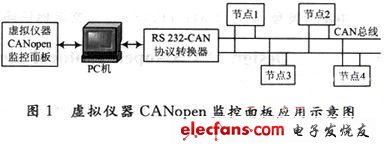Abstract: In view of the online monitoring problem of industrial field distributed bus network, it is proposed to combine the virtual instrument software with visual programming environment and CANopen, the high-level communication protocol of fieldbus, to develop an intelligent and efficient synchronous real-time monitoring interface. On the basis of analyzing the CANopen protocol identifier, the CANopen data message is packaged and parsed using the virtual instrument, and the VISA interface is used to complete the data transmission and reception through the self-designed RS 232-CAN protocol converter, and finally the development of the monitoring panel is completed. The development trend of the integration of fieldbus and virtual instrument technology has played a certain role. Key words: CANopen protocol; virtual instrument; fieldbus; VISA interface Virtual instrument is a product of deep integration of electronic measurement technology and computer technology. It realizes various functions of traditional instruments through the combination of software and hardware, which greatly breaks the limitations of traditional instruments in data processing, display, transmission and storage. Users can easily maintain, expand and upgrade their instruments. The user's operation of the virtual instrument panel through a friendly graphical interface is as convenient as operating a real instrument. The CAN protocol only defines the physical layer and the data link layer. It is not complete in itself. Some complex application problems require a higher-level protocol, the application layer protocol. The CANopen protocol standardizes the formation and transmission of communication data in a CAN network and gives users a great deal of freedom, allowing users to add new features they need at any time. In this paper, the application of virtual instrument technology to CANopen protocol is beneficial to real-time monitoring and data acquisition in distributed industrial sites, improving the operational efficiency of fieldbus network communication systems, and improving real-time and information processing capabilities. 1 CANopen protocol overview The CANopen protocol is a higher-level protocol defined by the CiA Association for the incompleteness of the CAN protocol - the application layer protocol. Communication between different CANopen devices is done by exchanging communication objects. 1.1 Communication object CANopen communication objects transmitted over a CAN network can be described by services and protocols. Classified as: real-time data is transmitted through the Process Data Object (PDO) protocol; Service Data Object (SDO) protocol is used to read and write the object dictionary; Special Function Object Protocol provides specific applications, network synchronization, timestamps, and emergency messages. Transmission; Network Management (NMT) protocol provides network initialization, error control and device status control services; Layer Setup Service (LSS) protocol is used to configure CAN bus communication parameters and device parameters. 1.2 CANopen predefined connection set To reduce the configuration effort of a simple network, CANopen defines a mandatory default identifier (CAN-ID) allocation table. These identifiers are available in the pre-operational state and can be modified by dynamic allocation. The CANopen device must provide the corresponding identifier to the communication objects it supports. The default ID allocation table is based on an 11-bit CAN-ID, including a 4-bit Function Code (FuncTIon Code) part and a 7-bit Node ID (Node-ID) part. The Node-ID is defined by the system integrator and ranges from 1 to 127 (0 is not allowed). The predefined connection set defines 4 receive PDOs (Receive-PDO), 4 transmit PDOs (Transmit-PDO), 1 SDO (occupy 2 CAN-IDs), 1 emergency object and 1 node error control ID. . It also supports the broadcast of the NMT-Module-Control service, SYNC and TIme Stamp objects without confirmation. The default values ​​for identifiers are shown in Table 1, Table 2. 2 CANopen monitoring panel industrial control field application framework The virtual instrument software LabVIEW is used to develop the CANopen protocol monitoring panel, and the CANopen data is received and transmitted to realize the data monitoring of the distributed industrial fieldbus network. LabVIEW is a virtual instrument application programming environment developed by National Instruments. It is a graphical programming language, especially suitable for developing measurement and control applications. It has standards for all common programming environments, such as data structure, loop structure and event processing. It has a variety of professional tool packages built in to meet engineering application development. The application is shown in Figure 1. The RS 232-CAN protocol converter monitors the data of each node on the field bus in real time to complete the control task. China leading manufacturers and suppliers of DC Support Capacitors,DC Capacitor, and we are specialize in Electrolytic capacitor,High Voltage Capacitor, etc.DCMJ DC Support Capacitors DCMJ DC Support Capacitors,Capacitors High Voltage,Dc-link Filter Capacitor,Dc Film Capacitors YANGZHOU POSITIONING TECH CO., LTD. , https://www.pst-thyristor.com
